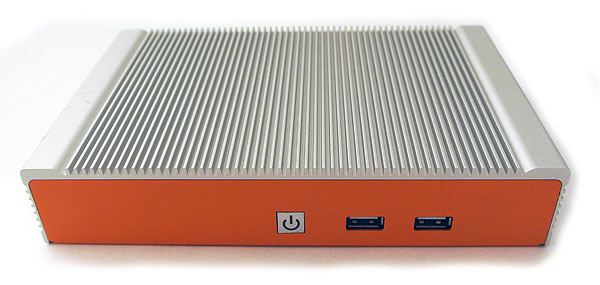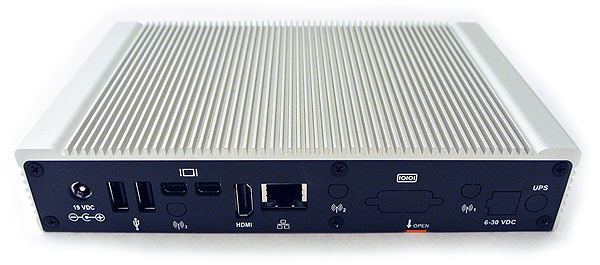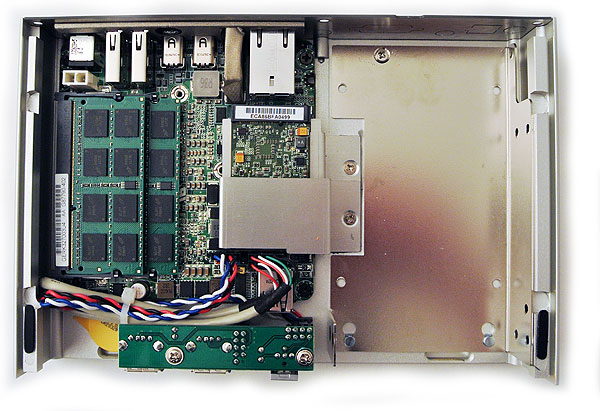Seven Small (But Powerful) Mini-PCs, Reviewed
LGX ML300
Why you can trust Tom's Hardware
Logic Supply's ML300 is a bit of an oddity in our round-up because it's not aimed at the same audience as the other contenders, although there are some client applications that could benefit from its unique selling points. While Logic Supply will build your system for you, you can also purchase the ML300 enclosure on its own for $129.
This chassis differentiates itself by being a dust-proof, vent-less industrial case. No fans and no vents mean no active cooling, so you also don't have to sweat a fan failure. See the ribs on the top of the chassis? The entire exterior serves as a passive heat sink for the processor; this works surprisingly well.
Logic Supply configures systems to order. Our review sample came with an Intel Core i5-3427U sporting 3 MB of shared L3 cache. Its 1.8 GHz base clock rate scales as high as 2.8 GHz under the right thermal conditions. Intel's on-die HD Graphics 4000 engine can handle very mainstream gaming, but that's about it. The machine we're looking at sells for $1245.65, making it the most expensive entry in our round-up. But remember that it's also armed with 16 GB of DDR3-1600, has the only bundled mSATA-based SSD, and includes an operating system.
Of course, if you're content to build your own passively-cooled mini-PC, you can save some money by buying the ML300 and platform components separately.
Bundle And First Impression
In the plain cardboard box you'll find Logic Supply's ML300, an AC adapter, a power cord, an HDMI-to-VGA adapter, wall, VESA, and DIN rail mounting hardware, and Windows. A lack of fancy packaging suggests this product's industrial focus.
The front of this compact system features a power button and two USB ports. Measuring 7.72" x 1.45" x 5.17", the enclosure is roughly equivalent to one and a half NUCs. More surface area is necessary to cool the internally-housed processor passively, and to accommodate more I/O.
The back plays host to a power plug, two more USB ports, a pair of mini-DP outputs, an HDMI connector, and a GbE interface. Cutouts for other connections exist, but are not populated.
Open the chassis up and you'll see all of its extra expansion space. Our review unit doesn't have Wi-Fi or Bluetooth support, but there is a mini-PCIe slot under the mSATA-based SSD, though. Logic Supply uses an Emphase 128 GB model, along with two 8 GB DDR3-1600 SO-DIMMs with 11-11-11-28 timings.
Special Features And Livability
An ultra-compact form factor is ideal for commercial applications, and a fan-less enclosure with nothing but solid-state components is ideal for ruggedness. With a wide range of mounting options and room for expansion, the ML300 chassis works well for its target market; it's a specialized piece of equipment that effective satisfies a specific need.
| Header Cell - Column 0 | LGX ML300 |
|---|---|
| Chipset | Intel QS77 Express |
| CPU | Intel Core i5-3427U, Dual-Core, Hyper-Threaded, 1.8 GHz (2.8 GHz Peak Turbo Boost), 3 MB Shared L3 Cache |
| Graphics | Intel HD Graphics 4000, 350 MHz - 1.15 GHz |
| Graphics Memory | Shared with system memory |
| System Memory | 2 x 8 GB Transcend PC3-12800, 1600 MT/s DDR3, 11-11-11-28-1T |
| Hard Drive | Emphase Enterprise 128 GB SSD, mSATA |
| Optical Drive | N/A |
| Operating System | Windows 7 Professional x64 |
| Included Peripherals | Not Included |
| Internal Interfaces | |
| Memory Support | Dual-Channel, 2 x DDR3/L/-RS SO-DIMM slots, 1.35/1.5 V, 1333/1600 MT/s, 16 GB Max |
| Mini-PCIe | Not Included |
| mSATA | One slot |
| Mass Storage Controllers | |
| Chipset SATA | 1 x mSATA 6Gb/s |
| I/O Panel Connectors | |
| DVI | Not Included |
| VGA | Not Included |
| HDMI | 1 |
| DisplayPort | 2 (mini-DP) |
| Thunderbolt | Not Included |
| MHSL Input | Not Included |
| USB | 2 x USB 2.0, 2 x USB 3.0 |
| Memory Card Reader | Not Included |
| Network | 1 |
| eSATA | Not Included |
| Digital Audio out | HDMI |
| Analog Audio | Not Included |
| IR Sensor | Not Included |
| Ethernet & Wireless | |
| LAN | Integrated Gigabit |
| Wi-Fi | Not Included |
| Bluetooth | Not Included |
| Audio | |
| HD Audio Codec | HDMI: Intel Display Audio |
| Audio Channels | HDMI 7.1 Digital Audio |
| Physical Specifications | |
| Size | 196 x 36.75 x 131.20 mm(7.72" x 1.45" x 5.17") |
| Weight | 1111 g (2.45 lbs) |
| Price | |
| As Tested: $1245.65 (with Windows 7 Ultimate x64; tested with Windows 8.1 Professional)Case Only: $129 (Logicsupply) |
Get Tom's Hardware's best news and in-depth reviews, straight to your inbox.
Don Woligroski was a former senior hardware editor for Tom's Hardware. He has covered a wide range of PC hardware topics, including CPUs, GPUs, system building, and emerging technologies.
-
outlw6669 Not a single AMD based SFF PC?Reply
I am disappoint, this would be a great area for AMD to show their competitiveness. -
ta152h @outlw6669I built one based on the A6 5200, and it's perfect for what I need it for. It's low power, more than fast enough for what 99% of the people do, quiet, and inexpensive. I'm a little surprised they didn't choose something based on the Jaguar for that reason, but it might just be a situation where nothing with one was sent to them for review. Certainly this is a poor representation, without both Jaguar and Bay Trail missing. I got to the first page, read what they had, looked at the cases, and moved on. Reading about different versions of Ivy Bridge and Haswell and how they compare to each other is profoundly uninteresting.Reply -
m32 I wouldn't mind having a small system like this. Maybe Mid-Year when everyone's CPU/APUs are out, I'll have the chance to make a smart buy. Thanks for the article. :)Reply -
mesab66 It is interesting that by going slightly larger with the enclosure space (still keeping within cube/rectangle/media player shape) opens up the possibility of so much more power....dedicated gfx, full cpu, etc etc., and, can be cheaper to build - depending on the users requirements.......of course, at the cost of power requirements, etc. I'm thinking most folk would ideally chose a slightly larger form factor for living room/media pc duties.On the other hand, if constraints are tight (form factor in this article) and the end user's requirements match, then these options are worth considering.Reply -
s997863 Power. I don't care about no power. Where's the love for the old games? If I want to play some of the classics which just don't emulate properly, I have to hunt for a heavy old Pentium3 box and try to get it working. How about a cheap mini PC with miniaturized legacy hardware for full compatibility to dual-boot win98 & XP, with gameports, VGA & S-Video, PS/2 & USB, IDE & SATA external ribbon & power connectors, & a turbo button for choosing between 2 processors 200MHz & 3GHz?Reply -
vertexx I am a huge fan of compact systems. Almost everything I have built has been ITX. But I've had a hard time with the NUC form factor. As a desktop, I think it's actually too small. One of those boxes would get lost on my desk, continuously being pushed around by other clutter. Now, if I had a hutch with an optimally sized cubby, that might be a different story.Reply
VESA mounted on the back of a monitor, these look really clunky, and I'd rather go with an AIO kit using the thin mini-ITX form factor where I have more control over processor choice.
I'd be more excited if this technology and form factor were applied in a more interchangeable system with a standardized GPU socket. I really like what ASRock and Gigabyte have done with their compact systems. They're not as compact, but having something a little more substantial on my desk is a good thing, and they pack a lot of punch. I just wish the standards were developed to allow builders to replicate that feat - pipe dream, I know.
One thing is for sure, AMD needs to develop it's own equivalent of the NUC and thin Mini-ITX. The success of it's Kaveri line I think would be helped out by innovation in form factor. -
axehead15 I think you should compare the Mac Mini to these, that way we can see how it adds up.Reply




